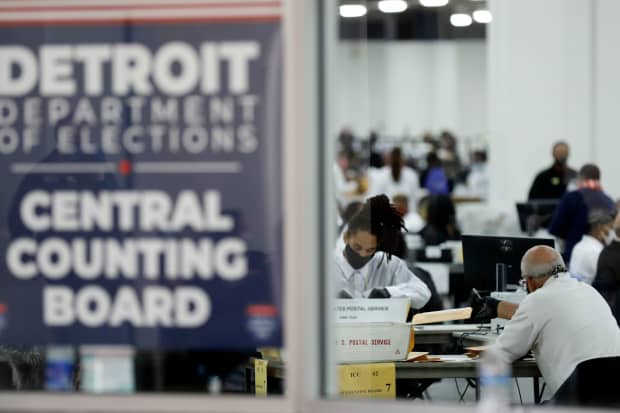This post was originally published on this site

Detroit election workers work on counting absentee ballots for the 2020 general election. President Donald Trump trailed Democratic challenger Joe Biden as almost all the votes were counted.
Jeff Kowalsky/Agence France-Presse/Getty Images
Halloween came three days earlier, but it was Election Night that turned out to be a nightmare for America’s pollsters.
For the second straight presidential election, pollsters underestimated Donald Trump’s share of the vote and whiffed badly on some key Senate races in battleground states.
Leading up to the vote, polls strongly pointed to a cresting “blue wave” in which Joe Biden would win the presidency, Democrats would expand their majority in the House and the party would seize control of the now Republican-led Senate.
Biden seems to have the inside edge on winning the White House, if by a much smaller margin than polls indicated. Democrats are also poised to lose a handful of seats in the House while the Senate appears increasingly out of reach.
The misfire has spawned a new round of criticism of the polling industry and raised fresh questions about whether polls can be trusted. Democrats were particularly upset by the inaccuracy of the surveys.
Let’s start with the national surveys. The RealClearPolitics average, which aggregates results from leading pollsters, indicated that Biden would win nationally by a margin of 51.2% to 44%. The closely followed FiveThirtyEight website similarly showed Biden on track to receive 51.8% of the vote to just 43.4% for Trump.
At last count, Biden held an edge of 50% to 48%, though it’s likely his lead will widen as all the votes from California, the U.S.’s most populous state, are tabulated.
What happened? Polls appear to have undercounted voters who lack college degrees for the second election in a row.
Conservatives contended that scores of Republican voters were either missed by pollsters or were unwilling to reveal their true preferences because of the perceived stigma of voting for Trump.
According to that theory, these so-called shy voters flocked heavily to the president, offsetting a large increase in Democratic turnout and helping to keep some Senate seats in Republican hands.
Trump also appeared to make inroads among some Hispanic voters and even African Americans, according to exit polling from Edison Research.
The errors by pollsters were especially pronounced in key battleground states. Trump won Ohio, Iowa and Florida with relative ease and kept it close in states such as Wisconsin in which he was shown to be trailing badly in recent polling.
Most notably, Biden was forecast to win in Wisconsin by almost 7 points, with one ABC poll putting his lead at a whopping 17 points. Instead, Biden looks like he’ll scrape out a victory there by less than 1 percent.
Pollsters also missed badly on a handful of critical Senate races.
Republican Lindsey Graham was shown to have a small lead over Democratic rival Jaime Harrison — he won by double digits.
Republican Sen. Susan Collins of Maine, for her part, did not lead in any one of the 15 polls conducted in the state since February. She won a convincing victory by almost 9 points based on the latest numbers.
Sen. Joni Ernst, an Iowa Republican, trailed in most polls and only narrowed the gap in the final weeks of the race.
Just days before the election, a widely respected Des Moines Register poll showed Ernst winning comfortably — much to the surprise of other pollsters and political prognosticators. Some dismissed the poll as an aberration. It wasn’t. Ernst won by about 6 points.
The failure of pollsters to capture the full scope of what turned out to be a very close election is likely to leave voters and political prognosticators even more skeptical of trusting them in the future.


